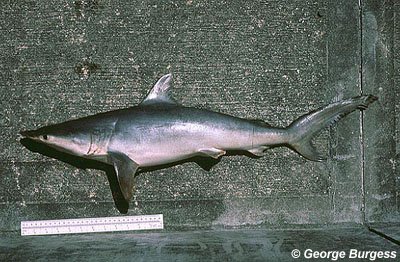
Carcharhinus isodon
This small slender shark gets its name from its rows of small, fine, clear teeth. This social shark forms schools to hunt fish like menhaden and mullet, sometimes energetically chasing them into the beach surf (Castro, 1993).
Order – Carcharhiniformes
Family – Carcharhinidae
Genus – Carcharhinus
Species – isodon
Common Names
- English: Finetooth shark, Eventooth shark, Night shark, and Smoothtooth shark
- Dutch: Fijntandhaai
- French: Requin à petites dents
- Spanish: Galana dientefino, Tiburón de noche, and Tiburón dentiliso
Importance to Humans
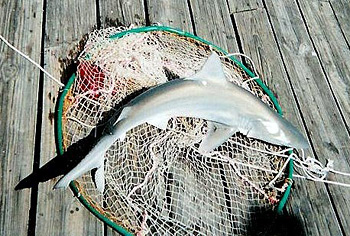
In the western Atlantic, this shark may be incidental by-catch on floating longlines in inshore waters but is considered to have little overall economic importance to the commercial shark fishery. However, local fishermen may target them with gillnets close to shore. In the northern Gulf of Mexico, they are taken occasionally by rod and reel, and the meat is marketed either fresh or dried-salted (Portnoy et al. 2016).
Danger to Humans
While this shark is not involved in any reported injuries, care should be taken when handling these sharks (Compagno et al, 2005).
Conservation
Finetooth sharks are considered to be of least concern according to the IUCN. Gillnet bans in Florida, Georgia, South Carolina, and Texas have proved to be helping the population of these sharks (Portnoy et al. 2016). Due to the coastal nature of this shark, they avoid most gillnet fishing that occurs out of state waters. Finetooth sharks are also managed in the US Fisher management Plan for Atlantic tunas, swordfish, and sharks.
> Check the status of the finetooth shark at the IUCN website.
The IUCN is a global union of states, governmental agencies, and non-governmental organizations in a partnership that assesses the conservation status of species.
Geographical Distribution
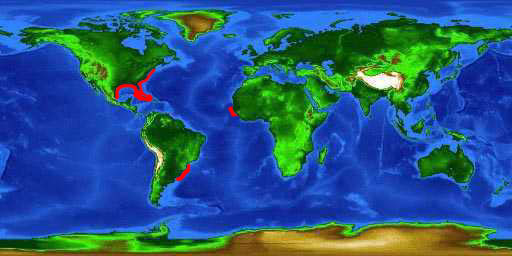
The finetooth shark is distributed in the western Atlantic Ocean from North Carolina (U.S.) south to Cuba and southern Brazil, including the Gulf of Mexico (Portnoy et al. 2016). Although there have been reports of this shark in the eastern Atlantic Ocean, in particular in Senegal and Guinea-Bissau, these sightings have not been confirmed and may be a result of confusion with the spinner shark (Carcharhinus brevipinna).
Habitat
Residing in waters close to shore to depths of 10 m (32.8 ft), this coastal species often forms large schools. The deepest waters they go in is at 152 m (498 ft) (Compagno et al. 2006). Adults and juveniles are common in shallow coastal waters off South Carolina during the warm summer months and migrate south when surface water temperatures drop below 20°C (68°F). This population of finetooth sharks spend the winter months in the waters off the coast of Florida. These sharks are often found near estuaries, lagoons, bays, and off river mouths, as long as the salinity is within their range (Compagno et al. 2006).
Distinguishing Characteristics
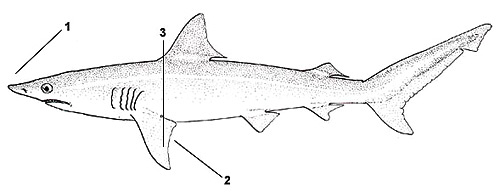
1. Snout pointed, shorter than the width of the mouth
2. Fins unmarked, the undersides of the pectoral fins are pure white
3. First dorsal fin originates behind the insertion point of pectoral fins along inner margin
Biology
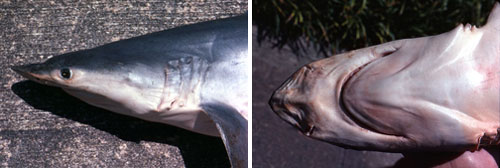
Distinctive Features
Small in size with a long pointed snout and fairly large eyes. The mouth is broadly rounded in the front with well-defined labial furrows around the corner of the mouth (Compagno et al. 2005). The gill slits are very long, about half the length of the base of the first dorsal fin. The origin of the first dorsal fin is over or just slightly posterior to the insertions of the pectoral fins. The first dorsal fin is small with a short rear tip. The trailing edge of the first dorsal is falcate with a rounded apex. The second dorsal fin is moderately large with a short rear tip. The pectoral fins are small. Pelvic fins have narrowly rounded tips. The upper edge of the caudal fin is just about straight with a narrowly rounded tip. There is no interdorsal ridge on the finetooth shark (Compagno et al. 2005).
Species appearing similar to the finetooth shark include the lemon shark (Negaprion brevirostris), blacktip shark(Carcharhinus limbatus), and spinner shark (Carcharhinus brevipinna). The lemon shark can be distinguished by its second dorsal fin that is almost as large as its first dorsal. The blacktip shark and spinner shark have black-tipped fins while the finetooth shark lacks any distinguishing markings on the fins. (Grace, 2001)

Coloration
This shark is dark bluish-grey or bronze above, paling to grayish then to a white underside. There is an inconspicuous white band along the flank (Compagno et al. 2005). There are no distinguishing marks on the fins.
Dentition
This shark is named for its very small, clear, fine teeth. The upper teeth are narrow and weakly serrated or smooth with erect to slightly oblique cusps (Compagno et al. 2005). The lower teeth are erect with smooth cusps and transverse roots.
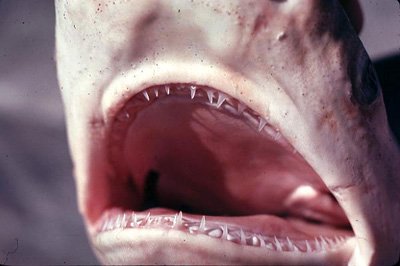
Denticles
Dermal denticles are small and overlapping. Each is a bit broader than long with blades containing three ridges, each with three short teeth with the median tooth longest (Castro and Peebles, 2011).
Size, Age, and Growth
The maximum reported size is 3.4 m (11.1 ft) TL (Compagno et al. 2005). Average lengths for male individuals is 1.5-2.3 m (5-7.4 ft) while females average about 1.8-2.3 m (5.9-7.5 ft) (Compagno et al. 2005). Males reach maturity at about 1.2 m (3.9 ft) in length and females mature at about 1.4 m (4.6 ft).
Food Habits
This predator mainly feeds on small bony fishes, including mullet, Spanish mackerel, spot, and Atlantic menhaden. This shark also preys on marine invertebrates including cephalopods and crustaceans (Bethea, 2003)
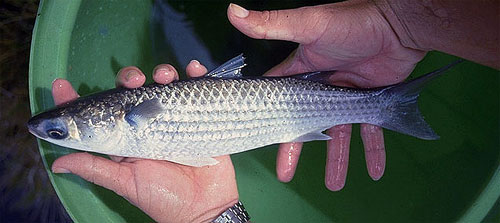
Reproduction
These sharks are viviparous, having a yolk sac placenta. The embryos are nourished through a placental connection. Gestation is approximately 12 months with the females moving into nursery areas in late May. Birth occurs from late May to mid-June. Each litter numbers 1-13 pups, each measuring 51-64 cm (20-25 inches) in length (Compagno et al. 2006).
Predators
Larger sharks, including the dusky shark (Carcharhinus obscurus).
Parasites
The parasite Phoreiobothrium triloculatum is known to sometimes inhabit finetooth sharks. This parasite also can affect other related sharks in the Carcharhinus genus. It is found in the spiral valves of the sharks (Caira and Jensen, 2009).
Taxonomy
The finetooth shark was originally named Carcharias isodon by Valenciennes in 1839. However, the name combination was changed to Carcharhinus isodon later that same year (Valenciennes, 1839). The genus name Carcharhinus is derived from the Greek “karcharos” = sharpen and “rhinos” = nose. The species name isodon means “equal tooth” for the same number of teeth located in the upper and lower jaws. A synonym referring to this species in previous scientific literature is Aprionodon punctatus Gill 1861.
Revised by: Demaris Raimundo and Tyler Bowling 2020
Prepared by: Cathleen Bester
References:
- Caira, J. and Jensen, K. (2009). Erection of a New Onchobothriid Genus (Cestoda: Tetraphyllidea) and the Description of Five New Species from Whaler Sharks (Carcharhinidae). Journal of Parasitology, 95(4), pp.924-940.
- Castro, J. and Peebles, D. (2011). Sharks of North America. New York: Oxford University Press, USA, pp.421-425.
- Compagno, L., Dando, M. and Fowler, S. (2005). Sharks of the world. Princeton, N.J.: Princeton University Press.
- Grace, M., 2001. Field guide to requiem sharks (Elasmobranchiomorphi: Carcharhinidae) of the Western North Atlantic (Vol. 153). US Department of Commerce.
- Bethea, D.M., 2003. Foraging ecology of the early life stages of four shark species (Rhizoprionodon terraenovae, Carcharhinus limbatus, Carcharhinus isodon, and Carcharhinus brevipinna) in Apalachicola Bay, Florida.
- Portnoy, D.S., Hollenbeck, C.M., Bethea, D.M., Frazier, B.S., Gelsleichter, J. and Gold, J.R., 2016. Population structure, gene flow, and historical demography of a small coastal shark (Carcharhinus isodon) in US waters of the Western Atlantic Ocean. ICES Journal of Marine Science, 73(9), pp.2322-2332.
- Castro, J.I., 1993. The biology of the finetooth shark, Carcharhinus isodon. Environmental Biology of Fishes, 36(3), pp.219-232.